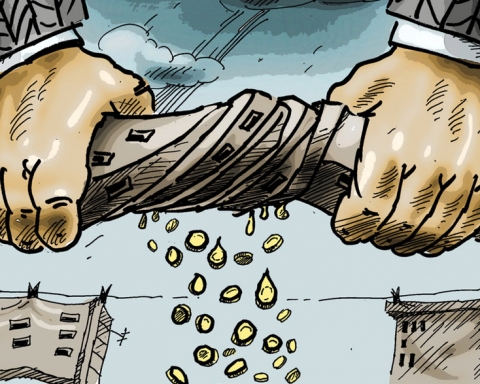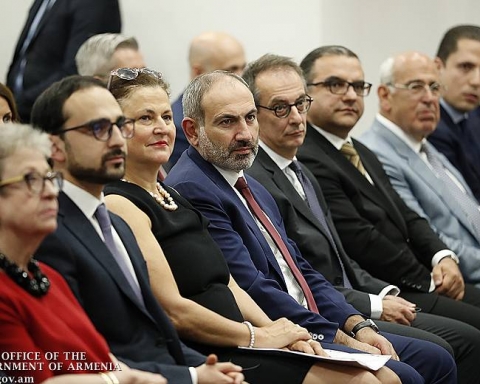The Chronicle of Everyday Corruption
ANIF FOUNDATION։4 BILLION AMD Spent on Salaries with No Accountability
Recently, the head of the cabinet finally admitted that the project of the national airline Fly Arna has failed. Perhaps he was the last to acknowledge it.
But upon closer examination, this was clear long ago, since the very beginning of the project, two years ago. There was a pompous, empty announcement with meaningless statements from the then-deputy prime minister and the young head of aviation. However, the failure of the airline is a topic that requires separate analysis. More notable is the activity of the Armenian shareholder of the airline, the ANIF fund.
This fund was created for the state’s investments in companies representing the so-called “national interest.” The state finances the fund – tranches in the form of grants from the prime minister’s office, the Ministry of Finance, or the Ministry of Economy. In short, it’s taxpayers’ money.
ANIF was created with pomp, with a board of directors including the deputy prime minister and the former prime minister of France.
The only result of four full years of ANIF activity was a 49% share in Fly Arna Airline. Taxpayers lost 4.4 billion drams on this investment alone, but it cannot be argued that this money cannot be returned. To declare it means to admit not only the failure of the airline project, but also financial losses, and these are questions for both officials and the fund’s management.
The only result of four full years of ANIF’s activity was a 49% stake in the Fly Arna airline. Taxpayers lost 4.4 billion drams just on this investment. It remains to be seen if the money can be recovered. Whether it can or not, it raises serious questions for both officials and the fund’s management.
But this is only the tip of the iceberg.
Coincidences
The fund has been plagued by scandals over the past year. At the end of 2023, the fund’s director was dismissed, and the former prime minister of France left the board of directors. Meanwhile, the Deputy Minister of Economy was appointed chairman of the Board of Directors, and on November 8, 2023, something extraordinary happened – the Minister of Economy, Vahan Kerobyan refused to approve the fund’s financial statements for 2022, as it “did not reflect the financial condition of the fund and its subsidiaries.” “It did not reflect,” was putting it mildly.
Three months later, the minister and his deputy were dismissed from their posts and became suspects in a criminal case. Clearly, there is an internal struggle within the cabinet of ministers. A struggle over what and who is involved and what side they are on- is yet to be understood.
Salaries
The fund has 30-40 employees. The payroll expenses for 2020-2022 amounted to about 4 billion drams, which means that each employee received an average of 125 million drams over three years. Perhaps, it’s too much for a single failed investment.
Why would the fund need so many employees if their only investment was Fly Arna? And even then, it was a passive investment? All other projects were carried out by a subsidiary fund of ANIF, which has its own employees and payroll.
Besides greed, what other explanation can there be for the fact that the fund paid large bonuses to all its employees at the end of each year? On what merits? for what successes? How can they justify salaries of 40-70 million drams per year coming from taxpayers’ money for managers, when many of whom are not even working full-time and have other jobs?
Expenditures
The fund didn’t hold back on its expenses. Despite paying out 1.3 billion drams annually in salaries, the fund spent 120 million drams per year on audit and consulting services. It’s strange, considering that the fund has in-house lawyers, financiers, accountants, etc. Another approximately 120 million drams per year was spent on external suppliers for public relations and market research. One may wonder which market.
Plus, there are incidentals – 2 million drams per month for rent and 2.5 million drams for business trips. Living lavishly is part of the job?
Strange reporting
The financial report for 2022 reflects only one investment – Fly Arna, amounting to 4.85 billion drams, despite the fact that the fund only invested 2.36 billion drams. In 2020 and 2021, the fund declared losses. It would have been the same in 2022, but the fund decided to increase the valuation of the Fly Arna investment by another 2.4 billion drams and record it as profit on paper. As a result, the fund showed a profit for 2022. And the auditor, KPMG, approved this report. The on-paper increase in the valuation of Fly Arna was justified in the report by using the discounted cash flow (DCF) method, which forecasted explosive growth of 256% for 2023 and 28-72% from 2024-2026. But in 2023, the airline did not grow; the number of passengers for the first and second quarters of 2023 was the same as in the fourth quarter of 2022. During the preparation of the report and audit in July 2023, it was already clear that the forecast was far from being realized, but the valuation was not changed by the company and was approved by the auditor. It’s strange, to say the least.
ANIF’s financial report does not reflect the activities of the subsidiary fund “Entrepreneur+Government,” although all ANIF projects listed on their website were carried out through this subsidiary fund, which we will discuss separately.
Non-transparency
The fund’s structure, goals, transactions, and conflicts of interest are not reflected anywhere. There is a weak presentation website with declarative statements.
The fund is silent about Fly Arna. What is the reason for the failure? No one has stated the reasons. Lack of funds? Few passengers? Ban on flights to Europe? Corruption? Poor management? Does the fund really not care what happened to its only investment?
About one billion drams were spent on public relations, consulting, marketing, and business trips. No reports mention the names of the suppliers. Perhaps taxpayers would like to know how such expensive services were provided on such a scale.
Non-accountability
The fund spends taxpayers’ money but is closed off from outside scrutiny. The phone number listed on the website is out of service. Calling the mobile number of the press secretary makes it clear, that they do not answer questions; you cannot talk to the project manager or the financial director – it’s the standard mantra of opaque companies: “If you have questions, write to us, we will answer.” Why does the fund need a full-time press secretary with a million-dram salary to work with the press and the public? It seems there is no information to share or, perhaps, press secretary is not competent enough to share it.
How will a potential investor communicate with the fund if there is no communication at all or are they not looking for the new investors?
***
From the perspective of a reasonable person, who’s familiar with the Armenian reality, numerous funds under all ministries spend taxpayers’ money without records and responsibility, while they are exempt from the requirements to declare income and property, that are imposed on citizens.
These are fake organizations whose sole purpose is to spend money. The discussions about the funds being the personal black coffers of high–ranking officials, and the significant part of the employees being on paper just to generate salaries, will remain at the level of rumors for now.
We will analyze the activities of these funds.
ANIF is just the first of them.
—-
Levon Khalatyan






